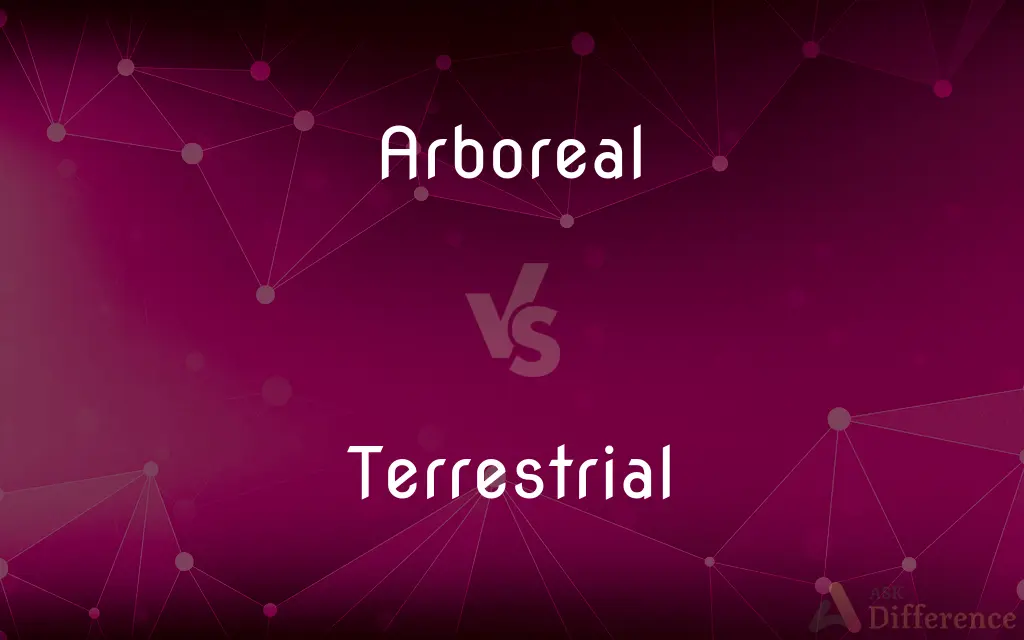Arboreal vs. Terrestrial — What's the Difference?
By Maham Liaqat & Urooj Arif — Updated on March 30, 2024
Arboreal refers to organisms that live in trees, highlighting an adaptation to aerial environments, while terrestrial denotes life on land, emphasizing ground-based habitats.

Difference Between Arboreal and Terrestrial
Table of Contents
ADVERTISEMENT
Key Differences
Arboreal creatures are adapted to life in the trees, evolving features like strong limbs and tails for climbing and swinging. On the other hand, terrestrial organisms have adaptations suited for life on the ground, such as sturdy limbs for walking or burrowing capabilities.
The arboreal lifestyle necessitates certain adaptations for vertical movement and living at heights, such as specialized claws or gripping pads. Conversely, terrestrial animals might exhibit adaptations like flattened bodies for burrowing or camouflage patterns for blending into ground environments.
Arboreal habitats are characterized by their three-dimensional space, offering niches like the forest canopy, which is rich in resources like leaves, fruits, and insects. Terrestrial habitats, while they may vary from forests to deserts, primarily offer a two-dimensional living space, with resources spread over the ground surface.
The challenges faced by arboreal species include the risk of falling and the need to navigate through a complex three-dimensional environment. Terrestrial species face their own set of challenges, such as avoiding predators on the ground level and finding shelter.
Arboreal and terrestrial environments influence the behavior of species, including their modes of locomotion. Arboreal species often exhibit brachiation, gliding, or agile climbing, whereas terrestrial species may show adaptations for running, digging, or stealthy movement.
ADVERTISEMENT
Comparison Chart
Definition
Relating to tree-dwelling organisms.
Relating to land-dwelling organisms.
Adaptations
Strong limbs, tails, gripping pads.
Sturdy limbs, burrowing capabilities.
Habitat Characteristics
Three-dimensional, resources above ground.
Two-dimensional, resources on the ground.
Challenges
Risk of falling, navigating heights.
Avoiding predators, finding shelter.
Locomotion
Brachiation, gliding, climbing.
Running, digging, stealth movement.
Compare with Definitions
Arboreal
Adapted for climbing.
The cat’s arboreal skills were evident as it scaled the tall oak.
Terrestrial
Living on or in the ground.
Terrestrial mammals include species like rabbits and elephants.
Arboreal
Resembling a tree in form and branching structure;
Arborescent coral found off the coast of Bermuda
Dendriform sponges
Terrestrial
Pertaining to land as opposed to water or air.
Terrestrial locomotion in animals includes walking and running.
Arboreal
Of or relating to tree-dwelling habits.
Arboreal snakes navigate the forest canopy with ease.
Terrestrial
Relating to the earth or to land.
Terrestrial ecosystems vary greatly in biodiversity and climate.
Arboreal
Living in or adapted to trees.
Monkeys are arboreal animals, spending most of their lives in trees.
Terrestrial
Earthly, worldly.
The telescope allowed for the detailed study of terrestrial landscapes.
Arboreal
Pertaining to trees.
The arboreal canopy is home to a diverse range of species.
Terrestrial
Of or relating to land-dwelling habits.
Terrestrial frogs differ from their aquatic cousins in habitat preference.
Arboreal
Relating to or resembling a tree.
Terrestrial
On or relating to the earth
Increased ultraviolet radiation may disrupt terrestrial ecosystems
Arboreal
Living in trees; arboreous
Arboreal apes.
Terrestrial
Of or on dry land
A submarine eruption will be much more explosive than its terrestrial counterpart
Arboreal
Of, relating to, or resembling a tree.
Terrestrial
An inhabitant of the earth.
Arboreal
Living in or among trees.
Terrestrial
Of or relating to the earth or its inhabitants.
Arboreal
Covered or filled with trees.
Terrestrial
(Biology) Living or growing on land or on or in the ground; not aquatic, arboreal, or epiphytic
Terrestrial mammals.
Terrestrial apes.
Terrestrial orchids.
Arboreal
Any tree-dwelling creature.
Terrestrial
(Astronomy) Similar to the planet earth in size or composition
Terrestrial planets.
Arboreal
Of or pertaining to a tree, or to trees; of nature of trees.
Terrestrial
Transmitted from structures on the earth and not involving satellites
Terrestrial radio.
Arboreal
Attached to, found in or upon, or frequenting, woods or trees; as, arboreal animals.
Woodpeckers are eminently arboreal.
Terrestrial
(Archaic) Of or relating to the earth rather than heaven.
Arboreal
Of or relating to or formed by trees;
An arborous roof
Terrestrial
An inhabitant of the earth.
Arboreal
Inhabiting or frequenting trees;
Arboreal apes
Terrestrial
(botany) A ground-dwelling plant.
Terrestrial
Alternative case form of Terrestrial
Terrestrial
Of, relating to, or inhabiting the land of the Earth or its inhabitants, earthly.
Terrestrial
Of, relating to, or composed of land.
Terrestrial
Living or growing in or on land (as opposed to other habitat); not aquatic, etc.
A terrestrial plant
Terrestrial
(astronomy) Of a planet, being composed primarily of silicate rocks or metals; see also terrestrial planet.
Terrestrial
Concerned with the world or worldly matters.
Terrestrial
(Mormonism) Of or pertaining to the second highest degree of glory.
Terrestrial
(broadcasting) Broadcast using radio waves as opposed to satellite or cable.
Terrestrial
Of or pertaining to the earth; existing on the earth; earthly; as, terrestrial animals.
Terrestrial
Representing, or consisting of, the earth; as, a terrestrial globe.
Terrestrial
Of or pertaining to the world, or to the present state; sublunary; mundane.
Vain labors of terrestrial wit.
A genius bright and base,Of towering talents, and terrestrial aims.
Terrestrial
Consisting of land, in distinction from water; belonging to, or inhabiting, the land or ground, in distinction from trees, water, or the like; as, terrestrial serpents.
The terrestrial parts of the globe.
Terrestrial
Adapted for the observation of objects on land and on the earth; as, a terrestrial telescope, in distinction from an astronomical telescope.
Terrestrial
An inhabitant of the earth.
Terrestrial
Of or relating to or inhabiting the land as opposed to the sea or air
Terrestrial
Of or relating to or characteristic of the planet Earth or its inhabitants;
Planetary rumblings and eructations
The planetary tilt
This terrestrial ball
Terrestrial
Operating or living or growing in water;
Boats are aquatic vehicles
Water lilies are aquatic plants
Fish are aquatic animals
Terrestrial
Concerned with the world or worldly matters;
Mundane affairs
He developed an immense terrestrial practicality
Terrestrial
Of this earth;
Transcendental motives for sublunary actions
Fleeting sublunary pleasures
The nearest to an angelic being that treads this terrestrial ball
Common Curiosities
What does arboreal mean?
Arboreal refers to organisms that live in or are adapted to trees.
What are terrestrial organisms?
Terrestrial organisms are those that live on the land or in a ground-based habitat.
How do arboreal animals adapt to their environment?
They develop adaptations like strong limbs for climbing, tails for balance, and gripping pads for holding onto branches.
What adaptations do terrestrial animals have?
Terrestrial animals may have adaptations such as sturdy limbs for walking, burrowing capabilities, and camouflage for protection.
What challenges do terrestrial animals face?
They must avoid ground-level predators, find food and water, and adapt to varying ground surfaces and cover.
Do arboreal species ever come to the ground?
While predominantly tree-dwelling, some arboreal species do come to the ground for various reasons such as foraging or nesting.
Can human activities impact arboreal species differently than terrestrial species?
Yes, deforestation and habitat destruction can have a more immediate and severe impact on arboreal species due to their reliance on tree habitats.
Can a species be both arboreal and terrestrial?
Some species may exhibit both arboreal and terrestrial behaviors, depending on their lifecycle or environmental conditions.
Why is arboreal locomotion challenging?
It requires navigating a complex three-dimensional space and avoiding the risk of falling from heights.
How do arboreal habitats differ from terrestrial habitats?
Arboreal habitats are characterized by vertical spaces in trees, while terrestrial habitats are spread over the ground.
What is an example of an arboreal species?
Many species of monkeys and some birds are examples of arboreal species.
Is arboreal living more advantageous than terrestrial living?
Each has its advantages and challenges, depending on the ecological niche and the specific adaptations of the organisms.
Give an example of a terrestrial species.
Elephants and tigers are examples of terrestrial species.
Are all birds considered arboreal?
Not all birds are arboreal; while many live in trees, others are terrestrial or aquatic.
How do terrestrial and arboreal species contribute to their ecosystems?
Both play crucial roles in their ecosystems, such as pollinating plants, dispersing seeds, and controlling insect populations.
Share Your Discovery

Previous Comparison
Incoming vs. Upcoming
Next Comparison
Monophthong vs. DiphthongAuthor Spotlight
Written by
Maham LiaqatCo-written by
Urooj ArifUrooj is a skilled content writer at Ask Difference, known for her exceptional ability to simplify complex topics into engaging and informative content. With a passion for research and a flair for clear, concise writing, she consistently delivers articles that resonate with our diverse audience.















































